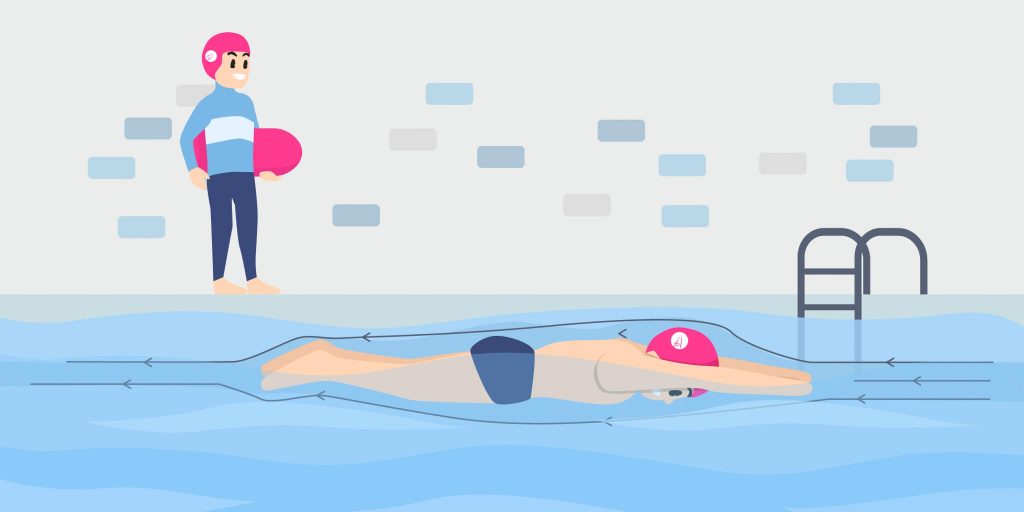Learn How To Swim Breaststroke

The oldest and slowest of the four swimming strokes is breaststroke. It uses the least amount of energy to continue moving and is the least effective stroke of all.
Despite its inefficiency, breaststroke is the least energy-intensive stroke and is best suited for swimming for survival.
Underwater propulsion is a series of coordinated movements by the arms and legs. The kick phase of the breaststroke is crucial for the motion and propulsion of the entire stroke.
The vast frontal resistance area formed when the heels come up toward the seat is the primary cause of the stroke’s sluggishness and inefficiency.
The body is already inclined due to the breathing technique, which raises resistance.
Typically, during adult swimming lessons, the instruction of breaststroke is introduced first, followed by the teaching of freestyle swimming.
The swimmer will see their location and buoyancy better thanks to the head and face clearing the water.
The general tactics for swimming breaststroke come in a wide variety.
People that swim breaststroke mostly do so for survival skills. Styles range from leisurely, languid swimming to intense competition.
Breaststroke Swimming History
The breaststroke has undergone the most alteration of any swimming technique.
Good Body Position Matters
For the leg kick recovery to occur underwater, the body should be near the surface, streamlined, and inclined from the head to the feet.
You should always keep your shoulders level throughout the stroke and limit head movement.
The opposing end of the body maintains its streamlined shape when one part enters its propulsive phase.
Breaststroke Kicking
Breaststroke initiation is essential. More effective than the kick of any other stroke.
Successful and seasoned breaststrokers possess a unique range of flexibility that enables their legs and feet to hold and scoop up more water while kicking.
When performing breaststroke kicks, people with a history of knee ailments can replace the dolphin kick (butterfly stroke).
The recovery, catch, and propulsive phases are the three main parts of the breaststroke kick.
However, it also works well to represent this particular kicking action. These phases are frequently used to describe the arm movements of the stroke.
The legs control the movement of the body forward. Therefore, the fundamental teaching feature of breaststroke legs is that the leg action consists of a series of activities that combine to form a single sweeping leg kick.
For breaststroke, there are primarily two types of kicking movements: the whip kick and the wedge kick.
There is constant discussion over which of these kicks improves our performance in the water.
Consequently, you should know both kicks if you’re a swimming instructor. The majority of the propulsion in the stroke comes from the leg action, and depending on which kick feels more natural to them, students will prefer a wedge kick or a whip kick.
The leg kick will provide more than 80% of the propulsion. Therefore, the entire leg-kicking motion should be fluid and simultaneous.
Knee bend as heels inch closer to butt.
You must pay additional attention to reduce resistance during this first portion of the kick, commonly referred to as the recovery stage.
Hide your legs between your hips and torso to streamline your body and reduce the angle your upper leg and torso produce.
In preparation for driving the water backward with the heels and soles of the feet, toes extend.
Legs sweep vigorously in a fluid circular motion outward and downward, speeding up as they kick.
Legs are brought back straight and together for a streamlined stance.
Breaststroke Arm Action
To allow our heads to rise above the water’s surface and breathe, the arms and hands pull in a circle and downward. Elbows must be tucked in; doing so will assist in the natural release of our bodies.
After inhaling, the hands will return to their stretched-forward position to prepare for gliding.
Breaststroke has undergone a lot of alterations over time. The amount of momentum produced by the arm pull has increased over time, making it more competitive.
The breaststroke arm action produces the smallest propulsions of the four competitive strokes.
Catch: The sweep-out, sweep-in, and recovery phases are the only three phases of the breaststroke arm movement.
With the hands and fingers firmly clasped, the arms are fully extended to start the movement.
Pitch outward and downward with hands at a 45-degree angle. From the side, it might have appeared to be drawn in the shape of a heart at the beginning of the catch phase.
As they approach shoulder-width apart, the arms stretch outward and downward.
After the catch phase, the elbow starts to bend, and the shoulders begin to roll in.
Arms sweep inward and downward during the propulsion phase. The hands will pull as far as they can go.
Elbows will remain elevated and bent at a 90-degree angle.
The hands sweep inward and slightly upward after the downward sweep.
As the hands draw inwards toward the chest and the chin, the elbows should be tucked into the sides of the chest.
Hands flex forward into a streamlined position as they recover.
Depending on the breaststroke style the instructor teaches, hands may recover in three positions: on, over, or under the water’s surface.
Breathing
When the head rises above the surface and the arms lower, breathing begins to take place. When the arms regain their forward position, breathing out happens.
Your torso will naturally elevate as you swim the breaststroke, which creates the perfect breathing position for inhalation.
As the body permits the head to elevate out of the water during the in-sweep, breathing will occur.
We have two breathing techniques at our disposal: trickle breathing and explosive breathing.
Exhalation occurs as the arms stretch forward to start the recovery phase, and the head dips back into the water.
Timing
The breaststroke timing can be summed up as pulling, breathing, kicking, and gliding, or kick, glide, pull, and breathing. Maintain a streamlined body position sequence to maximize the propulsive aspects of the stroke.
The legs will be streamlined as you pull with your arms during the propulsive phase. The arms will be streamlined as you kick your legs during the propulsive phase. Before each stroke, a full body extension is necessary.


